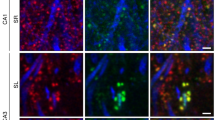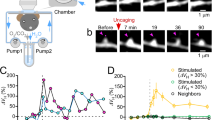Abstract
Activity-dependent competition of synapses plays a key role in neural organization and is often promoted by GABA; however, its cellular bases are poorly understood. Excitatory synapses of cortical pyramidal neurons are formed on small protrusions known as dendritic spines, which exhibit structural plasticity. We used two-color uncaging of glutamate and GABA in rat hippocampal CA1 pyramidal neurons and found that spine shrinkage and elimination were markedly promoted by the activation of GABAA receptors shortly before action potentials. GABAergic inhibition suppressed bulk increases in cytosolic Ca2+ concentrations, whereas it preserved the Ca2+ nanodomains generated by NMDA-type receptors, both of which were necessary for spine shrinkage. Unlike spine enlargement, spine shrinkage spread to neighboring spines (<15 μm) and competed with their enlargement, and this process involved the actin-depolymerizing factor ADF/cofilin. Thus, GABAergic inhibition directly suppresses local dendritic Ca2+ transients and strongly promotes the competitive selection of dendritic spines.
This is a preview of subscription content, access via your institution
Access options
Subscribe to this journal
Receive 12 print issues and online access
$209.00 per year
only $17.42 per issue
Buy this article
- Purchase on Springer Link
- Instant access to full article PDF
Prices may be subject to local taxes which are calculated during checkout







Similar content being viewed by others
References
Hensch, T.K. Critical period plasticity in local cortical circuits. Nat. Rev. Neurosci. 6, 877–888 (2005).
Nakayama, H. et al. GABAergic inhibition regulates developmental synapse elimination in the cerebellum. Neuron 74, 384–396 (2012).
Matsuzaki, M. et al. Dendritic spine geometry is critical for AMPA receptor expression in hippocampal CA1 pyramidal neurons. Nat. Neurosci. 4, 1086–1092 (2001).
Noguchi, J. et al. In vivo two-photon uncaging of glutamate revealing the structure-function relationships of dendritic spines in the neocortex of adult mice. J. Physiol. (Lond.) 589, 2447–2457 (2011).
Matsuzaki, M., Honkura, N., Ellis-Davies, G. & Kasai, H. Structural basis of long-term potentiation in single dendritic spines. Nature 429, 761–766 (2004).
Harvey, C.D. & Svoboda, K. Locally dynamic synaptic learning rules in pyramidal neuron dendrites. Nature 450, 1195–1200 (2007).
Zhou, Q., Homma, K.J. & Poo, M.M. Shrinkage of dendritic spines associated with long-term depression of hippocampal synapses. Neuron 44, 749–757 (2004).
Holtmaat, A. & Svoboda, K. Experience-dependent structural synaptic plasticity in the mammalian brain. Nat. Rev. Neurosci. 10, 647–658 (2009).
Kasai, H., Fukuda, M., Watanabe, S., Hayashi-Takagi, A. & Noguchi, J. Structural dynamics of dendritic spines in memory and cognition. Trends Neurosci. 33, 121–129 (2010).
Yang, G., Pan, F. & Gan, W. Stably maintained dendritic spines are associated with lifelong memories. Nature 462, 920–924 (2009).
Nowak, L., Bregestovski, P., Ascher, P., Herbet, A. & Prochiantz, A. Magnesium gates glutamate-activated channels in mouse central neurones. Nature 307, 462–465 (1984).
Mori, H. & Mishina, M. Structure and function of the NMDA receptor channel. Neuropharmacology 34, 1219–1237 (1995).
Magee, J.C. & Johnston, D. A synaptically controlled, associative signal for Hebbian plasticity in hippocampal neurons. Science 275, 209–213 (1997).
Markram, H., Lubke, J., Frotscher, M. & Sakmann, B. Regulation of synaptic efficacy by coincidence of postsynaptic APs and EPSPs. Science 275, 213–215 (1997).
Dan, Y. & Poo, M.M. Spike timing-dependent plasticity: from synapse to perception. Physiol. Rev. 86, 1033–1048 (2006).
Hensch, T.K. & Fagiolini, M. Excitatory-inhibitory balance and critical period plasticity in developing visual cortex. Prog. Brain Res. 147, 115–124 (2005).
Mataga, N., Mizuguchi, Y. & Hensch, T.K. Experience-dependent pruning of dendritic spines in visual cortex by tissue plasminogen activator. Neuron 44, 1031–1041 (2004).
Tanaka, J. et al. Protein synthesis and neurotrophin-dependent structural plasticity of single dendritic spines. Science 319, 1683–1687 (2008).
Lee, S.J., Escobedo-Lozoya, Y., Szatmari, E.M. & Yasuda, R. Activation of CaMKII in single dendritic spines during long-term potentiation. Nature 458, 299–304 (2009).
Kanemoto, Y. et al. Spatial distributions of GABA receptors and local inhibition of Ca2+ transients studied with GABA uncaging in the dendrites of CA1 pyramidal neurons. PLoS ONE 6, e22652 (2011).
Steele, P.M. & Mauk, M.D. Inhibitory control of LTP and LTD: stability of synapse strength. J. Neurophysiol. 81, 1559–1566 (1999).
Nishiyama, M., Togashi, K., Aihara, T. & Hong, K. GABAergic activities control spike timing- and frequency-dependent long-term depression at hippocampal excitatory synapses. Front. Synaptic Neurosci. 2, 22 (2010).
Abraham, W.C. & Goddard, G.V. Asymmetric relationships between homosynaptic long-term potentiation and heterosynaptic long-term depression. Nature 305, 717–719 (1983).
Nishiyama, M., Hong, K., Mikoshiba, K., Poo, M.M. & Kato, K. Calcium stores regulate the polarity and input specificity of synaptic modification. Nature 408, 584–588 (2000).
Wang, S.S., Khiroug, L. & Augustine, G.J. Quantification of spread of cerebellar long-term depression with chemical two-photon uncaging of glutamate. Proc. Natl. Acad. Sci. USA 97, 8635–8640 (2000).
Fino, E. et al. RuBi-glutamate: two-photon and visible-light photoactivation of neurons and dendritic spines. Front. Neural Circuits 3, 2 (2009).
Matsuzaki, M., Hayama, T., Kasai, H. & Ellis-Davies, G.C.R. Two-photon uncaging of gamma-aminobutyric acid in intact brain tissue. Nat. Chem. Biol. 6, 255–257 (2010).
Bai, D. et al. Distinct functional and pharmacological properties of tonic and quantal inhibitory postsynaptic currents mediated by gamma-aminobutyric acid(A) receptors in hippocampal neurons. Mol. Pharmacol. 59, 814–824 (2001).
Bernstein, B.W. & Bamburg, J.R. ADF/cofilin: a functional node in cell biology. Trends Cell Biol. 20, 187–195 (2010).
Lai, F.P. et al. Arp2/3 complex interactions and actin network turnover in lamellipodia. EMBO J. 27, 982–992 (2008).
Pontrello, C.G. et al. Cofilin under control of beta-arrestin-2 in NMDA-dependent dendritic spine plasticity, long-term depression (LTD), and learning. Proc. Natl. Acad. Sci. USA 109, E442–E451 (2012).
Lai, C.S., Franke, T.F. & Gan, W.B. Opposite effects of fear conditioning and extinction on dendritic spine remodelling. Nature 483, 87–91 (2012).
Bienenstock, E.L., Cooper, L.N. & Munro, P.W. Theory for the development of neuron selectivity: orientation specificity and binocular interaction in visual cortex. J. Neurosci. 2, 32–48 (1982).
Lisman, J. A mechanism for the Hebb and the anti-Hebb processes underlying learning and memory. Proc. Natl. Acad. Sci. USA 86, 9574–9578 (1989).
Yang, S.N., Tang, Y.G. & Zucker, R.S. Selective induction of LTP and LTD by postsynaptic [Ca2+]i elevation. J. Neurophysiol. 81, 781–787 (1999).
Naraghi, M. & Neher, E. Linearized buffered Ca2+ diffusion in microdomains and its implications for calculation of [Ca2+] at the mouth of a calcium channel. J. Neurosci. 17, 6961–6973 (1997).
Naraghi, M. T-jump study of calcium binding kinetics of calcium chelators. Cell Calcium 22, 255–268 (1997).
Adler, E.M., Augustine, G.J., Duffy, S.N. & Charlton, M.P. Alien intracellular calcium chelators attenuate neurotransmitter release at the squid giant synapse. J. Neurosci. 11, 1496–1507 (1991).
Markram, H., Roth, A. & Helmchen, F. Competitive calcium binding: implications for dendritic calcium signaling. J. Comput. Neurosci. 5, 331–348 (1998).
Wittenberg, G.M. & Wang, S.S. Malleability of spike-timing-dependent plasticity at the CA3–CA1 synapse. J. Neurosci. 26, 6610–6617 (2006).
Abraham, W.C. & Wickens, J.R. Heterosynaptic long-term depression is facilitated by blockade of inhibition in area CA1 of the hippocampus. Brain Res. 546, 336–340 (1991).
Rusnak, F. & Mertz, P. Calcineurin: form and function. Physiol. Rev. 80, 1483–1521 (2000).
Yang, E.J., Lin, E.W. & Hensch, T.K. Critical period for acoustic preference in mice. Proc. Natl. Acad. Sci. USA 109, 17213–17220 (2012).
Paulsen, O. & Moser, E.I. A model of hippocampal memory encoding and retrieval: GABAergic control of synaptic plasticity. Trends Neurosci. 21, 273–278 (1998).
Klausberger, T. & Somogyi, P. Neuronal diversity and temporal dynamics: the unity of hippocampal circuit operations. Science 321, 53–57 (2008).
Oh, W.C., Hill, T.C. & Zito, K. Synapse-specific and size-dependent mechanisms of spine structural plasticity accompanying synaptic weakening. Proc. Natl. Acad. Sci. USA 110, E305–E312 (2013).
Fiete, I.R., Senn, W., Wang, C.Z. & Hahnloser, R.H. Spike-time-dependent plasticity and heterosynaptic competition organize networks to produce long scale-free sequences of neural activity. Neuron 65, 563–576 (2010).
Govindarajan, A., Kelleher, R.J. & Tonegawa, S. A clustered plasticity model of long-term memory engrams. Nat. Rev. Neurosci. 7, 575–583 (2006).
Losonczy, A. & Magee, J.C. Integrative properties of radial oblique dendrites in hippocampal CA1 pyramidal neurons. Neuron 50, 291–307 (2006).
Rust, M.B. et al. Learning, AMPA receptor mobility and synaptic plasticity depend on n-cofilin-mediated actin dynamics. EMBO J. 29, 1889–1902 (2010).
Matsuzaki, M. & Kasai, H. Two-photon uncaging microscopy. Cold Spring Harbor Protocols 2011, pdb prot5620 (2011).
Ellis-Davies, G.C.R. A practical guide to the synthesis of dinitroindolinyl-caged neurotransmitters. Nat. Protoc. 6, 314–326 (2011).
Ellis-Davies, G.C.R., Matsuzaki, M., Paukert, M., Kasai, H. & Bergles, D. 4-Carboxymethoxy-5,7-dinitroindolinyl-Glu: an improved caged glutamate for expeditious ultraviolet and two-photon photolysis in brain slices. J. Neurosci. 27, 6601–6604 (2007).
Rial Verde, E.M., Zayat, L., Etchenique, R. & Yuste, R. Photorelease of GABA with visible light using an inorganic caging group. Front Neural Circuits 2, 2 (2008).
Chen, T.W. et al. Ultrasensitive fluorescent proteins for imaging neuronal activity. Nature 499, 295–300 (2013).
Acknowledgements
We thank K. Mizuno, K. Ohashi, G.J. Augustine, C. O'Donnell, S. Okabe and J. Eilers for discussions and C. Maeda, M. Ogasawara, H. Ohno, M. Ishikawa and K. Tamura for technical assistance. This work was supported by Grants-in-Aid for Specially Promoted Area (no. 21000009 to H.K.), Scientific Research (C) (no. 21500367 to J.N.), Scientific Research on Priority Areas ('Elucidation of neural network function in the brain', no. 20021008 to M.M.), Young Scientist (A) (no. 19680020 to M.M.), Scientific Research on Innovative Areas 'Mesoscopic Neurocircuitry' (no. 22115005 to M.M.), the Global COE Program ('Integrative Life Science based on the study of Biosignaling Mechanisms' to H.K.) and the Strategic Research Program for Brain Sciences ('Neuroinformatics of Emotion' to H.K.) from the Ministry of Education, Culture, Sports, Science, and Technology of Japan and by the US National Institutes of Health (grants GM53395 and NS69720 to G.C.R.E.-D.). In addition, this work was supported by a Mitsubishi Foundation grant to M.M. and a Research Grant from the Human Frontier Science Program to H.K.
Author information
Authors and Affiliations
Contributions
T.H., J.N. and H.K. conceived the experiments. T.H., J.N., M.M. and S.W. performed the slice experiments. A.H. and N.T. contributed to the molecular experiments. G.C.R.E.-D. synthesized the caged glutamate compound. H.K., J.N., T.H. and G.C.R.E.-D. wrote the paper.
Corresponding author
Ethics declarations
Competing interests
G.C.R.E.-D. has filed a preliminary patent declaration in the USA for the synthesis of dinitroindolinyl-caged neurotransmitters.
Supplementary information
Supplementary Text and Figures
Supplementary Figures 1–10 (PDF 954 kb)
Supplementary Data Set 1
Supplementary Data Set (XLSX 362 kb)
Rights and permissions
About this article
Cite this article
Hayama, T., Noguchi, J., Watanabe, S. et al. GABA promotes the competitive selection of dendritic spines by controlling local Ca2+ signaling. Nat Neurosci 16, 1409–1416 (2013). https://doi.org/10.1038/nn.3496
Received:
Accepted:
Published:
Issue Date:
DOI: https://doi.org/10.1038/nn.3496
This article is cited by
-
The Coordinating Role of the Actin Cytoskeleton in Short-Term Neural Network Plasticity Involving Excitatory and Inhibitory Synapses
Neuroscience and Behavioral Physiology (2024)
-
Generalized extinction of fear memory depends on co-allocation of synaptic plasticity in dendrites
Nature Communications (2023)
-
Cyclin D1—Cdk4 regulates neuronal activity through phosphorylation of GABAA receptors
Cellular and Molecular Life Sciences (2023)
-
Dissociation of functional and structural plasticity of dendritic spines during NMDAR and mGluR-dependent long-term synaptic depression in wild-type and fragile X model mice
Molecular Psychiatry (2021)
-
Mechanical actions of dendritic-spine enlargement on presynaptic exocytosis
Nature (2021)



